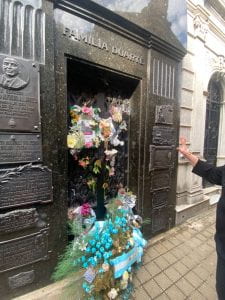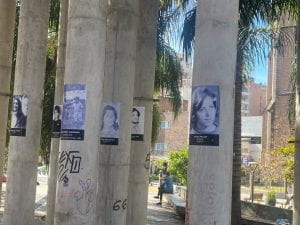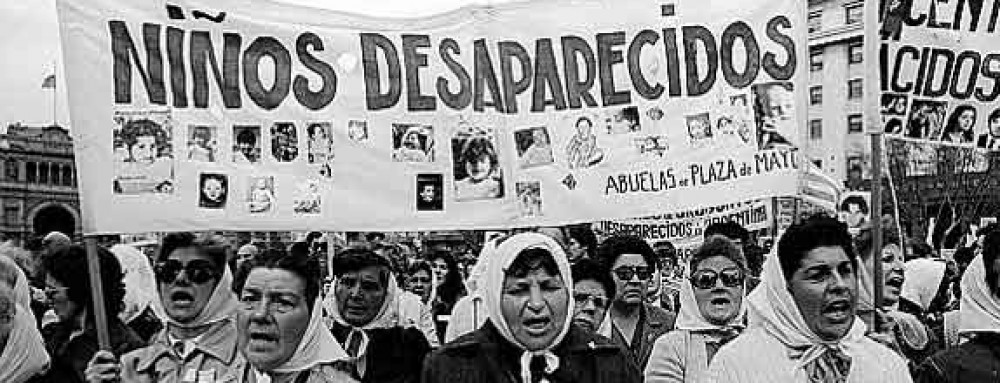When visiting what remains of Club Atletico, I was surprised by how little remained. One would assume that the destruction of what was once a detention center was intentional, but this was a coincidence. Similar to what happened at la perla, survivors have come together and have provided testimony of the horrors that occurred there. After the end of the dictatorship, the community in Buenos Aires came together to ensure that what happened at Club Atletico was not forgotten. I think that it is harder for me to grasp that this was a clandestine detention center because of how little of it remains, but I really admire the actions taken to ensure that no one forgets what happened here. Excavation is still happening at Club Atletico, so much like the other detention center we visited, a significant amount of evidence has not been discovered. For me, this memory site highlighted how these operations were done in plain sight. Although it is stated in Nunca Mas that even families with influence were scared to say anything to protect their family members, I could not imagine living in these neighborhoods or passing by these buildings while aware of what was happening and not saying anything. I could also not imagine being threatened by a government that was torturing and surveying its citizens. I think that Club Atletico being in such a public area should serve as a reminder of the people who were lost.
Author Archives: kclemmons5
Day in the life
 The drive to our hotel in Buenos Aires did not prepare me for what a beautiful and historical city this was. We first visited Recoleta a cemetery that mainly holds the bodies of politicians and celebrated figures in Argentina. We also passed the San Martin museum, as we learned in cordoba he is the liberator of Argentina and he has a square in every city. I enjoyed visiting the museum of Eva Peron. The most interesting thing we learned here was about her involvement in women’s suffrage. She was only able to vote once in her lifetime but she was such an important figure.
The drive to our hotel in Buenos Aires did not prepare me for what a beautiful and historical city this was. We first visited Recoleta a cemetery that mainly holds the bodies of politicians and celebrated figures in Argentina. We also passed the San Martin museum, as we learned in cordoba he is the liberator of Argentina and he has a square in every city. I enjoyed visiting the museum of Eva Peron. The most interesting thing we learned here was about her involvement in women’s suffrage. She was only able to vote once in her lifetime but she was such an important figure.
Eva Perón
Before visiting Eva Perón’s museum, I did not understand how important she was to Argentina. Seeing the mausoleum she now rests on also did not indicate her significance. Still, I now know that is the result of kidnapping and removal by the military. Evita accomplished so much in only 33 years. The transit home she opened seems to be the most significant. By purchasing a mansion for houseless women and children, she exclaimed that all people deserved to live an equal life and the sharing of wealth is necessary. I think the closest person to a First Lady similar to her in the US would have been Eleanor Roosevelt, but I am not entirely sure that is a fair comparison. Her role as a humanitarian shows the importance of upholding the freedoms of others. This idea is expressed in ‘Criminalizing Human Rights Violations,’ and I think Evita embodied these ideals perfectly. I thought it was interesting that we could not photograph any of her dresses because I think the very with most public figures who are women, their clothing has become idolized (I.e., Jackie Kennedy’s pink suit or Princess Diana’s wedding dress). Still, at this museum, it seemed as though they wanted the focus to be on her activism and not on what she was wearing.
Day in the life
My time in Cordoba has been very eventful and full of new experiences. Visiting the Gauchos and riding horses is definitely a memory I will not forget. Admittedly I was very nervous upon arriving at the ranch, but I soon forgot about those nerves upon meeting the puppies and walking around the land. When the first group left on their ride, I stayed behind and helped make empanadas and played with the puppies. When it was my turn to go the nerves returned briefly before we were off on our ride. When we returned we had an asado, and were treated to music from friends of Salvador. This has been one of my favorite experiences so far and I felt really welcomed in this area.
Keeping their memory alive
Hearing the stories of the disappeared was honestly heartbreaking, but visiting the D2 detention center made them even more heart-wrenching. For me, the most impactful part of the memory site was seeing the photos of the disappeared with their family and friends and the items they held near and dear to them. This showed me the significance of Ausencias Argentina. It also ensured that the victims of the government’s terror could be seen in their everyday lives with those they loved. The memory sites have kept the names of the disappeared known to ensure that no one has forgotten the how irreversible the damage done was. This made me think back to ‘A Single Numberless Death’ because these memorials have been into place to sure that everyone is remembered and this is signified by the fact that the memorials are so personal.
Monuments in Argentina
It is believed that upwards of 30,000 people were disappeared during the dirty war. Many of the disappeared were women who held very active roles in the human rights movement in Argentina. Parents who disappeared left behind children who were sometimes taken in by relatives, detained by the government, or put up for adoption. People who were disappeared have not been forgotten. Their memories have lived on through their friends and families. Just months after the war, memorials were created in their honor. At first, there were silhouettes, meant to represent the lives that had been lost. These soon became personalized when relatives wrote their family members’ names. The mothers who had lost children gathered in Buenos Aires while wearing white bandanas in honor of their children. This tradition has stood the test of time as the mothers still gather in their white bandanas today. During Fernando’s presentation, he showed images of memorials in Argentina, including pictures and the namelost people. He also took some time to show various monuments in America, many of which seemed impersonal. I think that America should take note of the actions and memorials put into place in Argentina and include more photos and allow friends and family members to be involved in honoring the memory of their loved ones. I believe that by making monuments and memorials feel more human we allow other victims and the loved ones of the lost to work through their trauma. This was discussed in ‘Trauma, forgiveness, and the witnessing dance: making public spaces intimate’, the author argues that forgiveness begins with trauma. In this context, I believe that it means that we cannot truly mourn as a society until we face our trauma and heal our wounds.
How Argentina Remembers the “Dirty War”
In “It Ought to Be A Crime: Criminalizing Human Rights Violations” Judith Blau and Alberto Moncada hypothesize that there is no real distinction between human rights violations and violations of humanitarian law. They go on to break down their argument and conclude with the insistence that denying people their human rights is a crime and a proposal to uphold this standard. Today this article became very relevant when we were visiting a memorial for women who disappeared and were killed after escaping captivity. Here Fernando told a story about his sister-in-law who was the daughter of militants who were disappeared. He spoke about how this impacted her and she did not realize her own imprisonment until decades later. She spent her life helping the children of the disappeared and It seems as though Argentina has monuments dedicated to those lost in the Dirty War. This has allowed them to never forget the horrors of that time. It also seems as though those who were witness to that period in Argentina are constantly doing work to ensure that their friends and family are never forgotten. Argentina also provides reparations to those impacted by the war. To me this means the government recognizes the crimes that have been committed in the past. While this is not gonna reverse the harm done in the past it is certainly a step forward. This is also comparable to one of the proposals written by Blau and Moncada which mentions that remedying human rights violations benefits societal and nonprofit organizations.
First days in Argentina

 Since landing in Argentina yesterday, I have been overjoyed at how lively the country the country was upon arrival. After a very hectic traveling day, we all gathered to get dinner at Storni, a restaurant filled with art, records, and a space for a band and dancing. When Laura Bonelli told us that late dinners were the norm here and this was confirmed. When we were leaving around 9 o’clock, it seemed as though the night was just getting started for everyone who arrived after us. We were also able to see the spirit of the people in Cordoba at a soccer match for the Instituto Atlético Central Cordoba. Singing could be heard from the stands throughout the game, and nearly everyone was wearing red and white. The game was exhilarating from beginning to end as the winning goal was scored less than 3 minutes before the end of the game.
Since landing in Argentina yesterday, I have been overjoyed at how lively the country the country was upon arrival. After a very hectic traveling day, we all gathered to get dinner at Storni, a restaurant filled with art, records, and a space for a band and dancing. When Laura Bonelli told us that late dinners were the norm here and this was confirmed. When we were leaving around 9 o’clock, it seemed as though the night was just getting started for everyone who arrived after us. We were also able to see the spirit of the people in Cordoba at a soccer match for the Instituto Atlético Central Cordoba. Singing could be heard from the stands throughout the game, and nearly everyone was wearing red and white. The game was exhilarating from beginning to end as the winning goal was scored less than 3 minutes before the end of the game.







